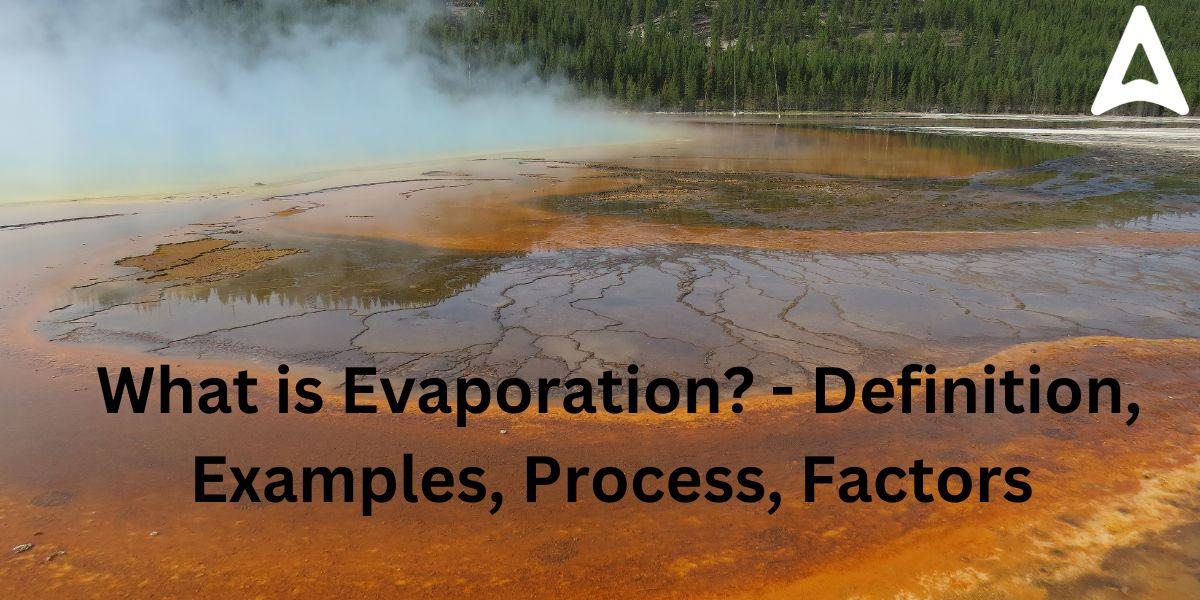Table of Contents
Evaporation
Evaporation: Evaporation is a natural process that comes into existence when a liquid substance is transformed into a gaseous state. The evaporation process plays an essential role in the water cycle, whereby water evaporates from the surface of oceans, lakes, and rivers, and then condenses into clouds that eventually precipitate as rain or snow.
However, evaporation is not only limited to the water cycle, as it also occurs in everyday life, such as when clothes dry on a clothesline or when a puddle of water disappears on a sunny day. In this article, we will provide you with information on the process of evaporation, its uses, and the science behind evaporative cooling. We will also examine the opposite phenomenon of condensation and how it relates to evaporation.
Evaporation Meaning
With rising temperatures, liquid water transforms into a gaseous state through evaporation. To initiate this process, it is essential to ensure that the temperature reading stands at precisely zero degrees Celsius or thirty-two Fahrenheit on any thermometer available for use.
As soon as you apply a scent, your body feels a small drop in temperature. This same phenomenon happens when water or acetone evaporates and changes from liquid to gas form.
The area of your body that comes in nearest proximity to acetone will undergo quicker and more prompt chilling because of its rapid evaporation, as opposed to water or other scented liquids.
What is a Cyclone? Know All about the Cyclone Disaster
What Is Evaporation?
A liquid transforms into a gas during evaporation.It is easy to visualise when raindrops “vanish” from puddles on a hot day or when wet clothing dries in the heat. Instead of really dissipating in these situations, the liquid water is evaporating into a gas known as water vapour.
Evaporation along with condensation and precipitation are the three processes in the water cycle. An overwhelming 90% can be attributed to a process called evaporation while the residual part comes from plant transpiration.
The majority of the time, liquid particles generally escape and turn into gas when a molecule close to the surface expends enough energy to exceed the vapour pressure.
When a liquid changes into gas, evaporation occurs and leads to evaporative cooling that extracts energy and causes a temperature decrease.
Global Warming- Definition, Causes, and Effects
Evaporation Process
As a liquid is heated, it evaporates. This indicates that the liquid’s molecules must develop kinetic energy. As a liquid gains kinetic energy, its molecules spread out and vibrate more quickly. The outcome is a change in the liquid’s state of matter, turning it into a gas.
Water is a typical material where evaporation occurs. Water changes from a liquid to a gas when energy or heat is applied because the bonds holding the molecules together start to weaken. At 100 degrees Celsius or 212 Fahrenheit, water is able to transit from a liquid phase into a gaseous state.
Read More: Greenhouse Gases Names
Why Does Evaporation Lead to Cooling?
Natural cooling is brought on by evaporation. This is based on the idea that matter must either receive or lose energy in order to change its condition. When matter molecules shift from a liquid to a gas, they need energy to use their kinetic energy to overcome their potential energy. As a result, the liquid takes this energy from its surroundings.
An alteration in the material’s temperature may occur when energy is transferred to or from its environment via various directions. Phase transition does not produce detectable heat transfer, despite the fact that the substance’s temperature rises during evaporation until the boiling point is reached.
When the substance reaches the boiling point, its molecules constantly absorb heat energy from its surroundings and chill those areas until they begin to separate from the liquid and transform into vapor.
The amount of energy needed for this phase shift is known as the latent heat of evaporation. Latent means “hidden,” thus until the entire liquid converts into vapour at the end of the evaporation process, this heat won’t affect the temperature reading on a thermometer.
Read More Water Cycle Diagram with detailed Explanation
Evaporative Cooling Uses
- To keep our bodies cool, we perspire. Evaporation is similar to transpiration. The water in our bodies evaporating uses energy, which lowers our body temperature.
- Cotton is what we wear during the summer. Cotton is a potent water absorber, thus it allows more sweat to contact the air, which encourages more evaporation. Because of this, wearing cotton clothing causes us to feel cooler.
- Water is stored in earthenware vessels to keep it cool.Similar to the pores in cotton fabric, the pores in the earthen pot’s surface area allow for more evaporation.
- An air cooler is particularly effective on hot, dry days. The underlying concept behind how an air cooler works is evaporative cooling. On a scorching day with dryness uncontrolled, the transformation of liquids into gaseous states increases in speed. This is due to extreme warmth and minimal humidity – two elements that expedite evaporation. Water absorbs energy from the atmosphere and turns into vapour.
What Is This Condensation?
This is the opposite of evaporation in that a gas changes into a liquid while losing heat energy. A good example can be the water droplets on the surface of a glass of ice-cold water. The water vapor that has been created by evaporation loses energy and turns into water when it comes into touch with the chilly tumbler.
What Is This Vaporization?
A material undergoes evaporation when it transforms from solid or liquid into gas. Evaporation refers to the conversion of liquids to gases that is nearby their surface areas and is considered one type of vaporization.
The cycle in which this occurs most commonly happens with water; when close enough to its body’s waterside, it evaporates effortlessly.
When materials transform directly from solids straight into gaseous phase matter as part of natural sublimation processes instead are called that term when describing such phenomena.





 UP, MP, CBSE Board Result 2025 Live Upda...
UP, MP, CBSE Board Result 2025 Live Upda...
 CUET UG Exam Date Sheet 2025 @cuet.nta.n...
CUET UG Exam Date Sheet 2025 @cuet.nta.n...
 NTA NEET Cut Off 2025, Expected Cutoff f...
NTA NEET Cut Off 2025, Expected Cutoff f...










